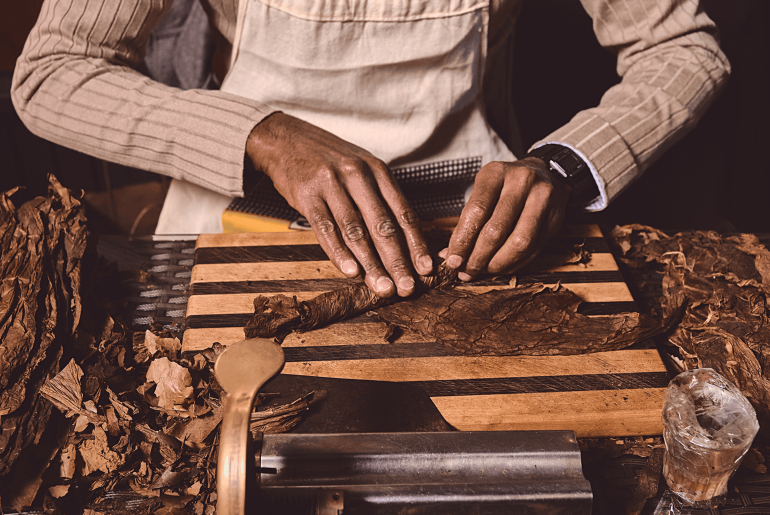Smoking a cigar is a fascinating journey that combines art, craftsmanship, and a touch of history. To truly enjoy and appreciate cigars, it helps to understand cigar anatomy and how they’re made. In this guide, we’ll take a closer look at the different parts of a cigar and explore the production techniques involved. Whether you’re a newbie or a seasoned enthusiast, this article will deepen your understanding and enhance your enjoyment of cigars.
External Features of a Cigar
Let’s start with the external features of a cigar. A cigar comprises three main components: the wrapper, binder, and filler.
The wrapper is the outermost leaf that adds character and aroma, while the binder holds the filler leaves together.
The filler is a blend of tobacco leaves that determines the cigar’s flavor and strength. These internal parts will be discussed in more detail later on.

When you look at a cigar, the wrapper immediately catches your eye. It’s the show’s star, with manufacturers striving for perfection in its appearance and texture.
A high-quality wrapper should be smooth and free of tears, holes, and prominent veins. However, small veins are normal and shouldn’t affect the smoking experience.
The wrapper serves three essential purposes: it covers the filler and binder, entices you with its color and clean lines, and contributes significantly to the overall flavor.
Wrapper
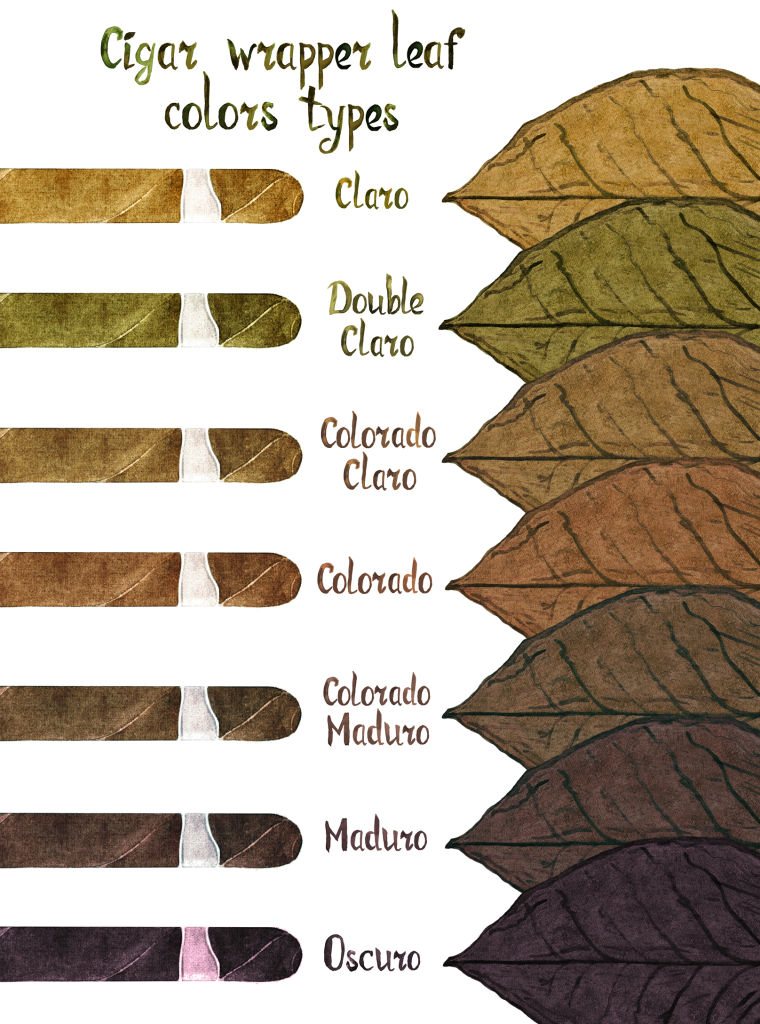
When we look at a cigar, the wrapper grabs our attention with its aesthetic attractiveness and feel. Manufacturers strive for perfection, methodically designing wrappers that are beautiful and smooth. A high-quality wrapper should be free of rips, holes, and visible veins, while minor veins are unavoidable.
The wrapper provides three essential functions: it encloses the filler and binder, entices the smoker with its uniform color and crisp lines, and significantly adds to the overall flavor profile.
The texture is a vital component of the wrapper’s character. Some leaves have a characteristic known as ‘tooth,’ which gives the wrapper a rough feel. These minor bumps are pockets of natural oils on the leaf’s surface, increasing the cigar’s taste.
A smooth texture isn’t always desirable since teeth add depth and complexity to the smoking experience.
The wrapper of a cigar is also the most labor-intensive component. This is especially true for two popular cultivars: Maduro and shade-grown.
Maduro Wrapper
A Maduro wrapper is created by a thorough curing and fermenting process that goes above and beyond the ordinary. Multiple re-bundlings, exposure to high temperatures, and considerable time are required. As a result, the leaf is black, thick, and intensely flavored.
Shade Grown Wrapper
Shade-grown tobacco refers to a farming method in which they grow the entire crop beneath cheesecloth or a similar screen. This reduces sunlight exposure and results in light-colored, almost blonde leaves. Shade-grown wrappers provide a smooth and creamy taste.
Maduro and shade-grown wrappers are examples of commitment and sophisticated manufacturing procedures. Whether it’s the laborious process of producing a dark and rich Maduro or the meticulous cultivation of a delicate shade-grown wrapper, it all contributes to a cigar’s overall character and pleasure.
Head and Shoulder
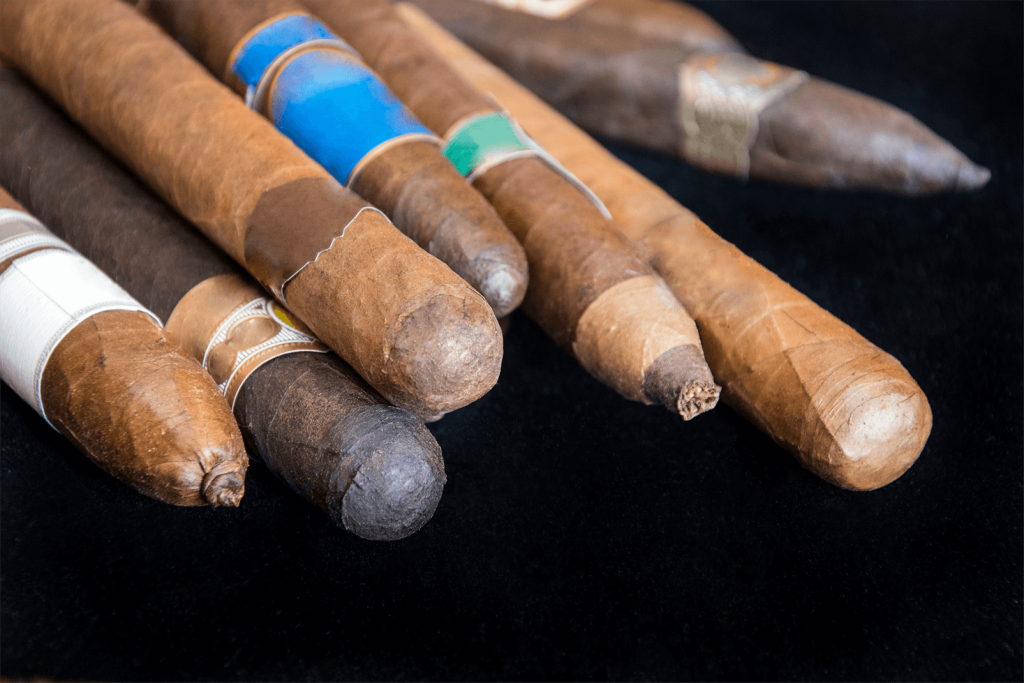
While the wrapper holds everything together, the head and shoulder are essential because they have the key to your cigar-smoking pleasure. The head comprises the cap and shoulder, with the cap perhaps the most essential part.
The Cap
The cap is a simple yet crucial part of the cigar – it keeps the internal components together before and during smoking. The cap ensures everything stays in place and your cigar doesn’t unravel before you can light up. The cap needs to be cut (or pierced) before you can smoke a cigar; otherwise, you’ll end up with an expensive handheld incense stick that requires constant relighting.
The shoulder is a bit vaguer to define because it varies between types of cigars – sometimes it’s long, other times short.
Generally, it refers to the part where the cap meets the cigar’s body. You’ll notice the shoulder is located near the head and is usually sloped towards the head or rounded.
The shoulder helps determine where to cut the head before toasting and lighting a cigar. Like the cap, the shoulder helps keep the cigar intact and prevent unraveling.
Cigar Body
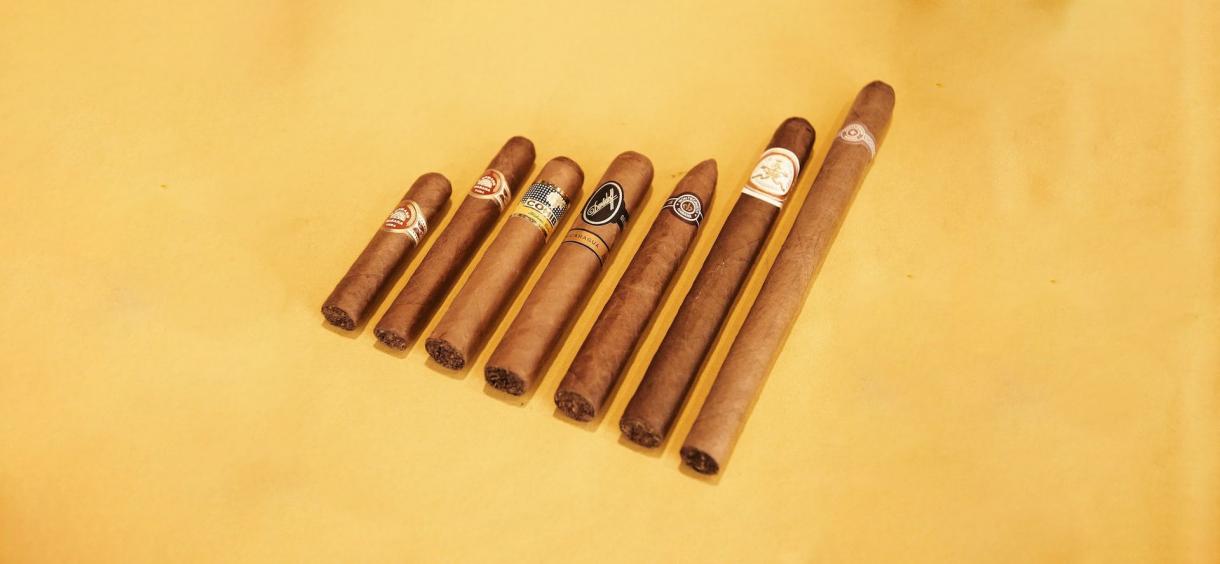
The body is where all the magical tastes of a cigar are stored. The body is the longest part of the cigar, and various shapes determine how long you can smoke a cigar – thicker bodies will burn longer. In contrast, thinner ones burn for a shorter time.
The Foot

The final part of the cigar is the foot – the end you’ll end up lighting. There are many variations on the theme of cigar feet, with the open foot being the most common. Other types of cigar feet include, but are not limited to:
- A shaggy foot where the internal, bunched filler tobacco extends beyond the wrapper
- The wrapper cover or seal the foot
- A tapered foot that tapers to a smaller size when compared to the rest of the body
Internal Anatomy of a Cigar
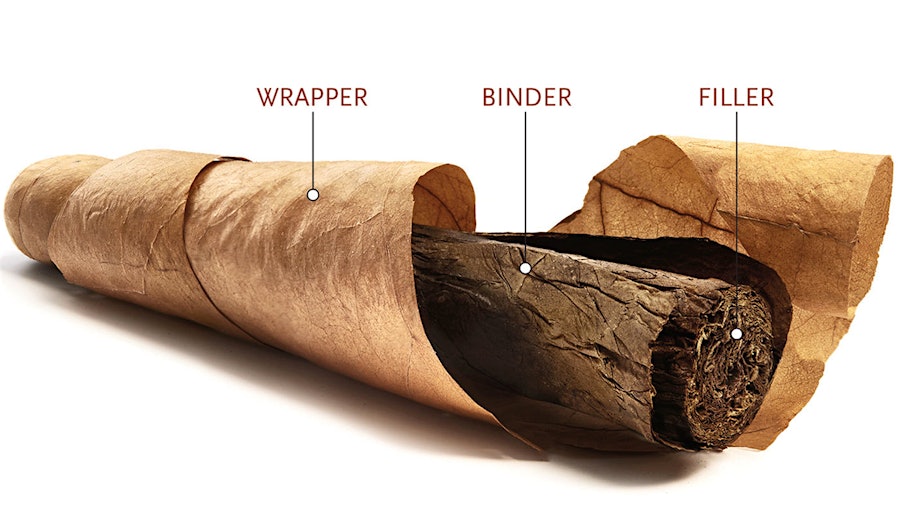
Now, on to the fun part—the internal cigar anatomy. Apart from the wrapper that keeps everything inside the cigar, there is the binder and filler tobacco, too. Their functions and importance, in brief, are:
- The binder leaf plays a vital role in maintaining the cigar’s shape and burn characteristics. It helps regulate the airflow, ensuring an even and controlled combustion. It contributes subtle flavors and nuances to the smoking experience.
- The blend of filler leaves determines a cigar’s flavor profile, strength, and complexity. Professional blenders carefully select and combine different leaves to create a well-rounded smoking experience.
Binder

The binder leaf is the layer beneath the wrapper and serves as the foundation of a cigar. It holds the filler leaves together, ensuring consistent burn and structural integrity.
Binder leaves are thicker and more durable than wrapper leaves. Often overlooked and underappreciated, the binder tobaccos play a crucial role in constructing a cigar. While they may be less visible and offer minimal flavor impact, we should not underestimate their significance.
The binder leaf is paramount in ensuring a consistent and even burn, vital for a satisfying cigar-smoking experience.
You may ask why I’m singing the binder leaf so many praises… The binder leaf acts as a guiding force, harmonizing the other tobacco components and preventing undesirable burn issues such as
- canoeing happens when only one side of the cigar burns, and the rest is still solid
- running looks like a seam, and forms a burning line down the barrel of the cigar, and there’s nothing you can do to stop it—the cigar splits open and ruins the entire experience, and allowing ash to fall everywhere
These potential mishaps can disrupt enjoyment and lead to an awful smoking experience. That’s why the binder deserves our attention and appreciation.
Unlike other tobacco leaves, binder leaves undergo a shorter curing process, which is unique to their role. They are carefully bunched and hung in pairs rather than sewn together to avoid any holes or weak spots that could compromise the burn quality.
This particular curing method ensures an even burn. It clinches the filler in place, maintaining the structural integrity of the cigar.
Let’s not forget the crucial contribution of the binder leaf. It may not have the spotlight in terms of flavor. Still, its impact on burn consistency is invaluable, guaranteeing a smooth and enjoyable smoking experience from start to finish.
Filler

Finally, we reach the filler, the last piece of the cigar puzzle, and it plays a crucial role in achieving that smooth and consistent burn we all crave. Unlike the other leaves in a cigar, the filler is made up of multiple leaves (sometimes from various countries) and parts of the tobacco plant.
This gives the cigar blender the freedom to mix and match, creating unique combinations that enhance the overall flavor and aroma. Skilled rollers carefully arrange these leaves to ensure the perfect airflow, complement the wrapper’s character, and deliver a reliable burn.
Consistency is vital when it comes to enjoying a cigar, and there’s one burn issue that sends shivers down the spines of aficionados: tunneling. It happens when the filler is too loose in certain spots, allowing the tobacco to burn too quickly and create a hollow channel.
This leads to a frustrating draw that feels empty and difficult to smoke, requiring more effort and potentially causing further burn problems. It’s a nightmare no cigar lover wants to experience.
That’s why the art of adequately bunching the filler is so essential. Not only does it preserve the carefully crafted blend’s delicate flavors, but it also prevents tunneling, and those dreaded plugged draws.
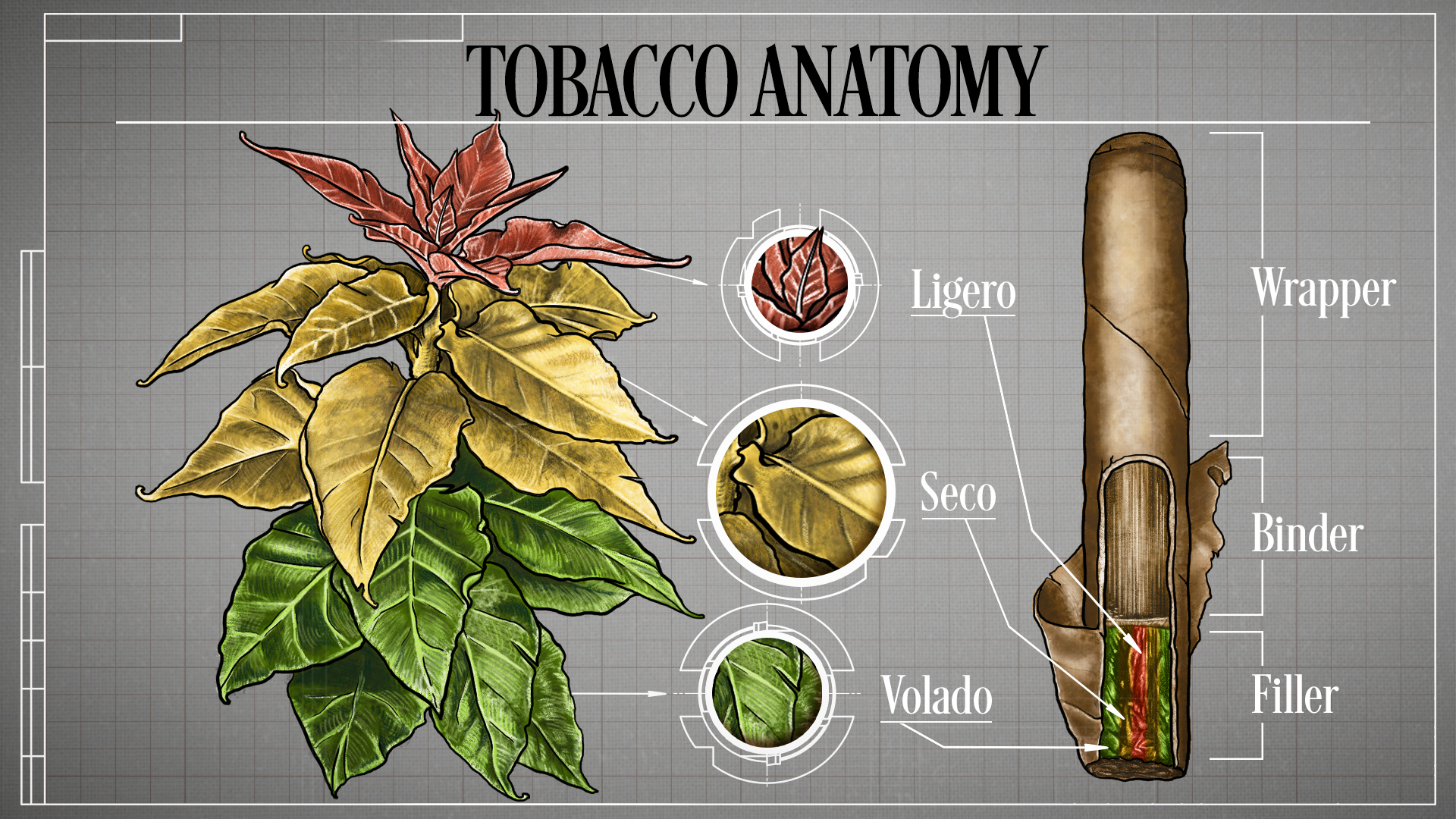
The filler tobacco leaves can be classified into three categories:
Ligero Tobacco Leaves
These leaves are sourced from the top of the tobacco plant, provide rich, robust flavors and contribute to the cigar’s strength.
Seco Leaves
Seco leaves are taken from the middle of the plant, add complexity, balance, and aroma to the blend.
Volado Leaves
Harvested from the lower part of the plant, this tobacco leaf contribute to the cigar’s smoothness and burn consistency.
Wrapping it All Up
Understanding the anatomy of a cigar enriches the smoking experience. Each part of a cigar contributes to its overall character and flavor profile, with the wrapper, binder, and filler playing distinct roles. The craftsmanship, attention to detail, and expertise required to create a premium cigar are evident throughout the production process. Embrace the tradition, savor the flavors, and immerse yourself in the world of cigars, knowing and appreciating how the parts of the whole contribute to creating your cigar.

